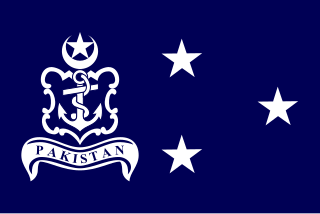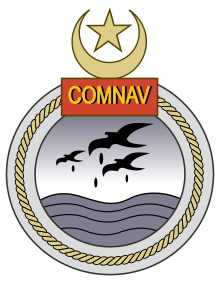
The Lockheed P-3 Orion is a four-engined, turboprop anti-submarine and maritime surveillance aircraft developed for the United States Navy and introduced in the 1960s. Lockheed based it on the L-188 Electra commercial airliner; it is easily distinguished from the Electra by its distinctive tail stinger or "MAD" boom, used for the magnetic anomaly detection (MAD) of submarines.

The ATR 72 is a twin-engine turboprop, short-haul regional airliner developed and produced in France and Italy by aircraft manufacturer ATR, a joint venture formed by French aerospace company Aérospatiale and Italian aviation conglomerate Aeritalia. The number "72" in its name is derived from the aircraft's typical standard seating capacity of 72 passengers.

The Boeing P-8 Poseidon is an American maritime patrol and reconnaissance aircraft developed and produced by Boeing Defense, Space & Security, and derived from the civilian Boeing 737-800. It was developed for the United States Navy (USN).

The Pakistan Navy (PN) is the uniform naval warfare branch of the Pakistan Armed Forces. The President of Pakistan is the Supreme Commander of the Navy. The Chief of the Naval Staff, a four-star admiral commands the navy. The Pakistan Navy operates on the coastline of Pakistan in the Arabian Sea and Gulf of Oman. It was established in August 1947, following the independence of Pakistan from the United Kingdom.

The Breguet Br.1150 Atlantic is a long-range maritime patrol aircraft designed and manufactured by French aircraft manufacturer Breguet Aviation.
The Indian Naval Air Arm is the aviation branch and a fighting arm of the Indian Navy which is tasked to provide an aircraft carrier-based strike capability, fleet air defence, maritime reconnaissance, and anti-submarine warfare.

The Zulfiquar-class frigate, also known as F-22P or in English: Sword class, is a class of multi-mission guided missile frigates, in service with the Pakistan Navy. The class is based on an updated model of the Chinese design, the Type 053H3. The frigates were designed and built jointly in Hudong–Zhonghua Shipbuilding in China and the KS&EW Ltd. in Pakistan.

The Pakistan Marines or simply as Pak Marines, is an expeditionary and amphibious warfare uniform service branch within the Pakistan Navy, consisting of the naval officers and other personnel to perform their duties within the Marines. Pakistan Marines are responsible for providing force protection in littorals, using the mobility of the Pakistan Navy to provide creeks defence, ground based air defence and Force protection.

The PNS Mehran is the naval station and the premier air–to-air/air–to–ground training naval air station located in the joint vicinity of the Faisal Air Force Base in Karachi, Sindh, in Pakistan. Established in 1975 with the cooperation of the Pakistan Air Force, the PNS Mehran serves in the capacity as the headquarter of the Naval Aviation Branch of the Pakistan Navy, and grown to its present inventory of 41 multi role aircraft. The latest addition in the Air Arm is the ATR-72.

INS Garuda, is an Indian naval air station located in Kochi, in the state of Kerala. Commissioned on 11 May 1953, it is the oldest operating air station of the Indian Navy.
Pakistan Naval Station Makran, known as PNS Makran formerly known as Coastal Naval Air Station, Pasni, is a Naval air station and a military airport located in Coastal city of Pasni, Balochistan. It's one of four active Naval Air Arm bases.
The Indo-Pakistani Naval War of 1971 refers to the maritime military engagements between the Indian Navy and the Pakistan Navy during the Indo-Pakistani War of 1971. The series of naval operations began with the Indian Navy's exertion of pressure on Pakistan from the Indian Ocean, while the Indian Army and Indian Air Force moved in to choke Pakistani forces operating in East Pakistan on land. Indian naval operations comprised naval interdiction, air defence, ground support, and logistics missions.
Military exercises are conducted by the Pakistan Armed Forces to increase combat readiness, and to identify problems in logistics, training, and current military doctrine. They also test the ability of units to work together. Lastly, they act as a visible expression of military might, which acts as a deterrent to potential enemy action. An important component of each exercise is the after-action assessment. Since 1989 the four branches services have increasingly begun coordinated exercises.

PNS Khaibar (DDG-183) is the Tariq-class destroyer currently in active duty in the Surface Command of the Pakistan Navy since 1994.

PNS Tippu Sultan (DDG-185), a Tariq-class destroyer, served in the Pakistan Navy after it was acquired in 1994. Her design was based on the British Type 21 frigate, and previously served in the Royal Navy as HMS Avenger as a general purpose frigate.
Rear-Admiral Abdul Waheed Bhombal, SI(M), best known as A. W. Bhombal was a two-star rank admiral in the Pakistan Navy and the chairman of the Pakistan National Shipping Corporation from 1980 until retirement from military service in 1986. Bhombal was disciplined by the Pakistani Navy for his role in the friendly fire sinking of PNS Zulfiqar after the missile attack on the Port of Karachi.

Commander Pakistan Fleet (COMPAK) is a formal title in the Pakistan Navy to denote the head as the commander of Pakistan Fleet Command with duties sanctioned by the navy for fleet support, progressive transition of the fleet, and ensuring effectiveness of the force. The COMPAK is also assigned with responsibilities to ensure combat and staff capabilities of the fleet such as deployment of the forces, in addition to ensure equipment capacities designed to improve "operational readiness".

The Tughril-class frigates, formally classified as the Type 054A/P frigates, are a series of modified guided-missile frigates built by Hudong–Zhonghua Shipbuilding (HDZH), for the Pakistan Navy. The Type 054A/P is a modified derivative of the Type 054A frigate and was specifically customised to meet the operational requirements of the Pakistan Navy; the class features several capabilities - including anti-surface warfare (ASuW), anti-aircraft warfare (AAW), anti-submarine warfare (ASW) and low radar observability. The frigates form the mainstay of the Pakistan Navy's active naval fleet. The class also supplants the obsolete Tariq-class destroyers.




















